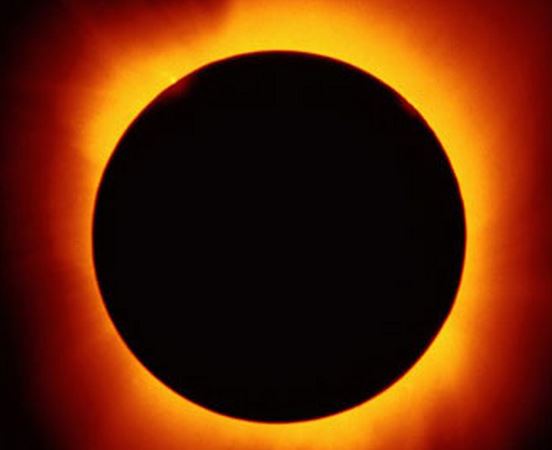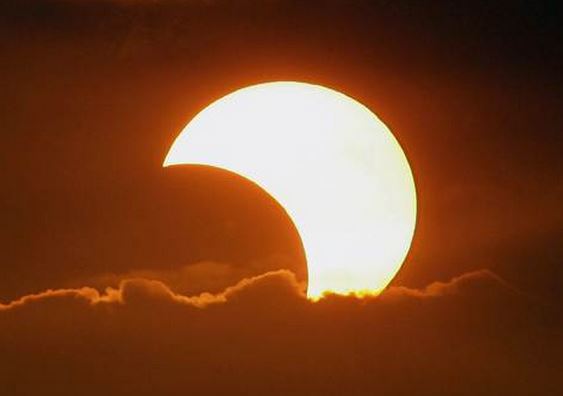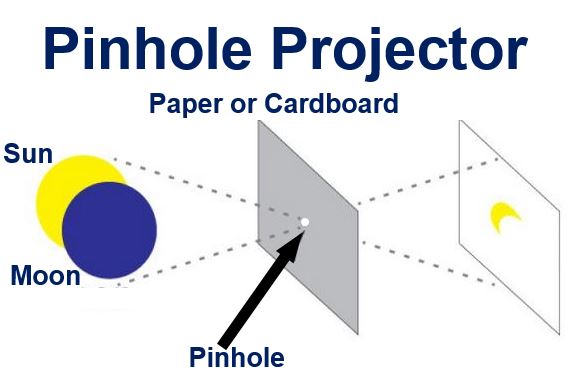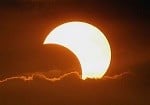The Moon will cast its shadow over Northern Europe on March 20th, 2015, completely blacking out (total solar eclipse) the region between Iceland and the Outer Hebrides, with the rest of the UK experiencing obscuration (darkness) of between 97% in the far north of the country to 85% in the south.
A solar eclipse, or eclipse of the Sun, occurs when the Moon is between the Earth and the Sun, blocking out the sunlight. The Moon casts a shadow on the earth’s surface. In fact there are two shadows: the umbra which gets smaller as it reaches the Earth, and the penumbra which gets larger.
A total eclipse – a complete blocking out of sunlight – can only be experienced by those in the area on the Earth’s surface that enters the Moon’s umbra (the smaller shadow). Those in the larger shadow, the penumbra, will see only a partial blocking of sunlight.

In a total solar eclipse all that is visible is the glow of the Sun behind (around) the Moon.
According to the British Astronomical Association (BAA), the event on March 20th will last longer than two hours.
The BAA said in a statement:
“Indeed, an obvious partial eclipse will be visible from every country in Europe and the partial phase will also be seen from places as widely spread as Newfoundland, North Africa and north-western Asia.”
If you live in the UK make the best, because there will not be another solar eclipse until 12th August 2026.
Protect your eyes
Do not look directly at the Sun with the naked eye, even during a partial eclipse. If you do, you risk severe eye damage and even blindness.
“The Sun can be viewed safely with the naked eye only during the few brief seconds or minutes of a total solar eclipse. Partial eclipses, annular eclipses, and the partial phases of total eclipses are never safe to watch without taking special precautions.”
“Even when 99% of the Sun’s surface is obscured during the partial phases of a total eclipse, the remaining photospheric crescent is intensely bright and cannot be viewed safely without eye protection.”

A partial solar eclipse.
In order to look at the Sun safely, you can either use special filters or project the image onto a screen.
According to the BAA’s Solar Eclipse Safety code:
“DON’T view the Sun through sunglasses of any type (single or multiple pairs), or filters made of black & white or colour photographic film, or any combination of photographic filters, crossed polarisers or gelatin filters, CDs, CD-ROMs, or smoked glass. These are NOT safe.”
“DO view the Sun ONLY through special filters made for safe solar viewing, e.g. aluminised mylar filters, or black polymer filters, identified as suitable for direct viewing of the Sun, bearing the CE mark AND a statement that it conforms to European Community Directive 89/686/EEC, or use a welder’s glass rated at No. 14 or higher. Always read and follow the manufacturer’s instructions carefully.”
Children should be supervised when viewing a solar eclipse.
Making a pinhole projector to view a solar eclipse
With a pinhole camera, also called a pinhole projector, you can project the image of the Sun with the Moon blocking the light onto a screen. They are easy to make, all you need are:
– two sheets of white cardboard, in fact, two sheets of normal white printer paper would also work.
– a pin or thumbtack.

A pinhole projector is cheap, safe and simple to set up.
With the pin or thumbtack make a small, round, smooth hole in the middle of one of the white sheets of cardboard (or paper).
Hold this sheet up to the Sun, stand with your back to the Sun to protect your eyes.
Hold the second sheet (with no hole), below the sheet with the hole so that an inverted image of the Sun is projected onto it.
You can make the image larger or smaller by moving the sheets either nearer or further away from each other.
The European solar power industry is concerned about being able to cope with fall in electricity supply, followed by surge two hours later.
BBC Video – Total Solar Eclipse 1999

